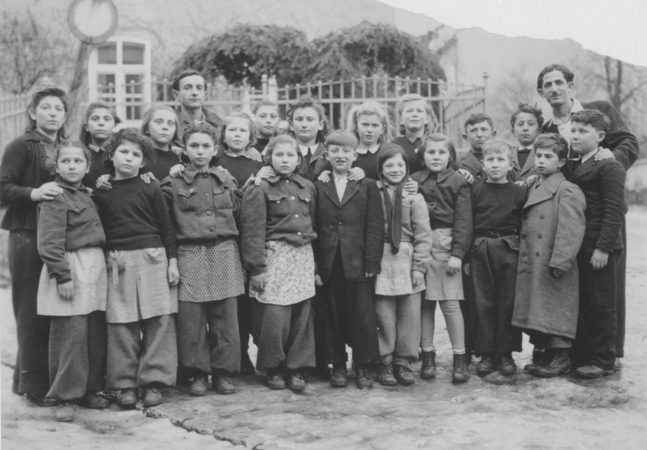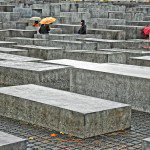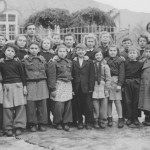
If this were any other subject than what it is, this post would be perfect for a click bit headline: “Hitler kills 6 million Jews, and you’ll never believe what happens next!” —
But here’s what I want to share with you.
I wrote the other day that I’d been reading Final Solution: The Fate of the Jews, by David Cesarani, a very comprehensive book on the Holocaust. Now, it seems to me that most works about the Holocaust stop with the liberation of the camps, or, if it’s an individual narrative, the story of how that particular survivor made his or her way to the United States (because most narratives that you read are by survivors who emigrated to the United States, just because they’re most likely to have something published in the U.S.). And certainly, I expect that most Americans’ knowledge ends with liberation, with, as a bit of an epilogue, the idea that the survivors left Germany for Israel afterwards.
But here’s some detail (from pages 772 ff):
In Poland, the numbers looked like this:
30,000 – 60,000 Jews survived by hiding in the cities or forests.
20,000 were still alive in ghettos and camps in Poland.
A few thousand returned from camps in Germany.
Between 13,000 and 20,000 returned from military service in the Red Army.
But the largest number of Polish Jews were those who had been deported by Stalin to Siberia/central Asia during the period from 1939 to 1941. Many died due to the conditions in the camps to which they were deported, but 166,000 survived and were repatriated after the war.
This puts the total number of Jews in Poland at between 232,000 – 269,000. (How does this number compare with other sources? Wikipedia gives a figure of 350,000 survivors including 230,000 in the Soviet Union. It’s hard to pair these numbers, given the shifting borders and population movements.)
But these returnees were not welcomed home by neighbors happy to see that they had survived. Instead, they faced further violence, by neighbors unwilling to return homes and property to the survivors, and by Polish nationalists who (in the time before the communists had fully taken control) viewed the Jews as communist collaborators. It’s been calculated that 600 – 750 Jews were killed by Poles after the war, including a massacre of 42 Jews in July 1947.
As a result, initial efforts at rebuilding within Poland were abandoned, and the Displaced Person camps which the Allies had so busily been emptying out, refilled with Polish (and, I think – but it’s not clear – other Eastern European) Jews, who concluded that Poland could no longer be their home.
Cesarani writes,
In December 1945 there were only about 1,800 children in the Jewish DP camps of Germany and Austria. One month after the Kielce pogrom the number reached 16,000 and by the end of the year there were 26,500 Jewish children in the US zone alone. The Polish Jews who had been exiled to the USSR had departed and come back as family units. Although conditions in places such as Kazakhstan were harsh it was possible to preserve family life, marry, and have children. Now these Polish Jews brought their families to Germany, creating new demands on the relief agencies and also generating new possibilities. The overall Jewish population rose to 141,000 in the American zone and 50,000 in the British zone during 1946, peaking at about 190,000 in Germany plus some 60,000 in other refugee centres. Although the vast majority of the Jewish DPs were now Polish, only a small proportion had actually endured German camps and ghettos. (p. 775)
which offered an explanation for a puzzling statement about the DP camps in the exhibits at the Holocaust Museum in Skokie; talking about revival after the war, the text moved from a “baby boom” among young survivors to the provision of services for children, showing happy preschoolers and school-aged children who were clearly too old to have been born following the war.
So, first of all, it is mind-blowingly ironic that Stalin’s deportations, while they destroyed communities and countless lives, in this case saved lives.
But, second, well, here’s something else to consider:
All those displaced people were waiting for the opportunity to leave for Israel or America. With respect to America, the path was cleared for an eventual 140,000 Jews (not just those in DP camps, but from elsewhere, too) by the Displaced Persons Act of 1948. With respect to Israel, Britain, which controlled Palestine subsequent to World War I, aimed to control the borders to prevent Jewish immigration to Palestine, and even kept would-be immigrants in camps in Cyprus, but large numbers came in illegally, and ultimately legally after Israeli independence in 1948.
One of the arguments I frequently read from Palestinian activists is that “the West gave Palestine to the Jews to make up for the Holocaust, but that’s unfair because the Palestinians had nothing to do with it.” And the rejoinders have to do with the historical connection of the Jews to the land, and the continuity of at least some numbers of Jews living there, and the fact that, until Jews began moving to the region, the area was a backwater, underdeveloped and sparsely populated, and it was the economic growth and farming advancements brought in by the Jews allowed it to support its growing population.
But it seems to me that the Holocaust isn’t really the right context, or at least not the complete context. Instead, the post-war context is just as significant. After the last shots were fired, there were massive relocations of ethnic groups, voluntary and not. Poles were removed from that part of Poland which the Soviet Union kept for itself after the war, and Ukrainians in Poland left for Ukraine/the Soviet Union. Ethnic Germans were expelled from Poland, Czeckoslovakia, Hungary, Yugoslavia, and the parts of Germany which were taken by Poland and the Soviet Union (Kaliningrad). Further afield, the Partition of India produced the relocation of millions of Hindus and Muslims in 1947, and closer to home, but further back in time, the population exchange between Greece and Turkey in the early 20s, was more orderly, but nonetheless a further instance of rearranging people by ethnic group (and remember, too, that until the dismantling of the Ottoman Empire following World War I, Palestine was just one region among many in the Ottoman Empire). And these were not the actions of criminal states like the Nazis, but of countries acting within established norms — Churchill and Truman were completely on board with the border re-drawing and deportations, and France even held onto the Saar region as a “protectorate” until it was allowed to rejoin Germany in 1957 (see Wikipedia).
This is, after all, what the majority of the DPs experienced — deportation to the Soviet Union, then a not-wholly-voluntary departure for the West.
So ideas of self-determination of nations and ethnic groups, and the notion of multi-ethnic countries singing kum-ba-yah — well, in the end, that’s all very new. And the difficulty with the situation of the Occupied Territories and the never-resettled refugees is that we have this traditional way of thinking of nations and peoples and the modern concept of self-determination bumping up against each other.
Image: children at the Schauenstein DP camp, https://commons.wikimedia.org/wiki/File:DP_class_at_Schauenstein_camp.jpg; public domain












